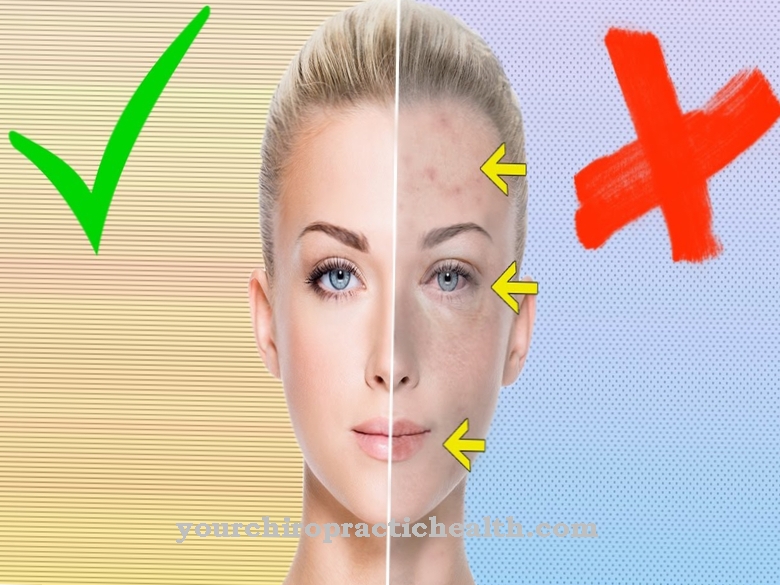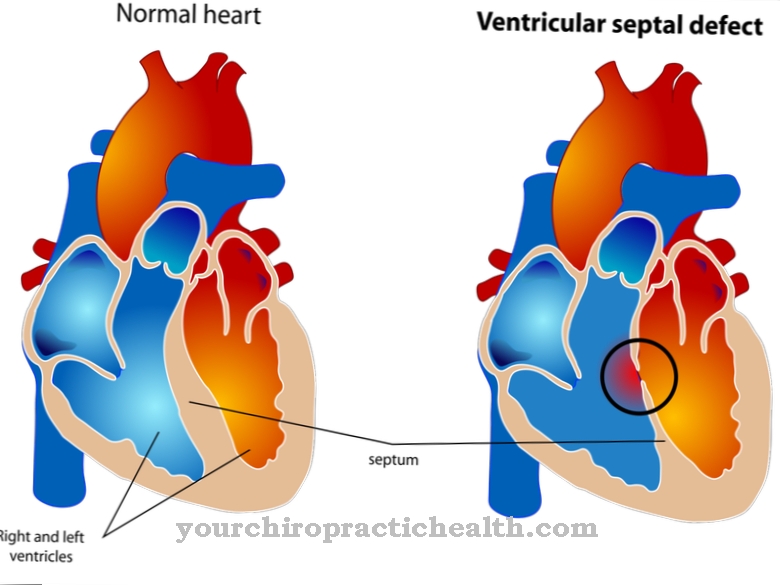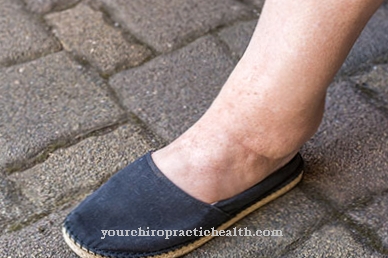It often happens that small children have a foot deformity, the so-called childlike arched archesthat is harmless and usually disappears on its own by the age of starting school.
What is a child's arch arch?

© Microgen - stock.adobe.com
As childlike arched arches This is a term used to describe a harmless foot deformity that often occurs in children, in which the heel is bent outwards in the shape of an X and at the same time the arch of the foot appears flattened like in flat feet.
This anomaly occurs in most children and has to do with the growth of the skeleton, which is why it is also referred to as the physiological arch arch. The misalignment is only noticeable after a child has started running. The natural gait is not hindered by this.
Most of the time, the child's flat arched feet will regress on their own by the age of starting school. Treatment only needs to be given if the gait is severely impaired and the deformity has not normalized sufficiently by the age of 7.
causes
The main cause of the childlike arch arches is therefore to be found in the physiological growth of a child. The main reason is the supporting structure of the foot, which differs from that of an adult.
Due to their anatomy, children have to turn their feet a little inward when walking and try to counteract this inward rotation by buckling the foot. This causes the foot to bend at the ankle and flatten the arch. This is also the reason why children often have knock knees.
But other, non-developmental causes can also come into question:
- Instability of tendons and ligaments
- weak muscles
- severe overweight (obesity)
- Knock knees or bow legs
- Paralysis, especially of the posterior tibial muscle
- Diseases of the bones
Typical symptoms & signs
- the heel is bent outwards, at the ankle
- X-position of the foot (buckle foot)
- the foot surface is flattened (similar to the flat foot), the arched foot is mostly on the ground
- Knock knees
Diagnosis & course
One childlike arched arches can be recognized from the outside by the X position of the ankle and the arch of the foot resting on the floor.
It is significant that the misalignment only occurs after learning to walk. This phenomenon is seldom painful, does not affect the natural gait at all, and usually disappears on its own at school age at the latest. A possible other cause should only be clarified if the symptoms are severe, e.g. B. a congenital flat foot or malformations / adhesions in the area of the foot bones.
The pediatrician usually makes the diagnosis by examining the child's foot and looking at the arch for flattening. To determine whether it is a child's physiological arch arch, he carries out further tests:
- Assessment of whether the arch of the foot is erect when standing on tiptoe
- Mobility of the ankle should be possible without pain
- Podogram (footprint) to see if the foot shows a normal child's silhouette
An X-ray examination will only be carried out in order to rule out other causes if there are severe restrictions on movement or pain. If necessary, the status is checked again at certain time intervals.
Complications
In most cases arch arch arch does not lead to particular complications or discomfort. This usually disappears again in school age, so that there are no consequential damages or restrictions in adulthood. Those affected suffer from a misalignment of the feet. This can lead to teasing or bullying, especially in children, and thus trigger depression or other psychological complaints.
It is not uncommon for patients to appear irritated and suffer from a greatly reduced self-esteem. The so-called knock knees also occur. The misalignment can lead to further restrictions in movement, so that the child can no longer easily perform certain sports. This can also disrupt child development.
In most cases, treatment for this disease is not necessary and the symptoms will go away on their own. If necessary, the diet and lifestyle must be changed. The symptoms can also be alleviated through various therapies and exercises. As a rule, there are no particular complications. The flat arch arch does not reduce the patient's life expectancy either.
When should you go to the doctor?
Parents who discover a malaligned foot in their child should consult their pediatrician or an orthopedic surgeon as soon as possible. Typical signs such as a flattened arch of the foot or knock knees point to a child's arched arches, which in any case requires a medical examination. If the misalignment is corrected early on, permanent damage can be avoided. A doctor's visit is necessary at the latest when the child complains of pain or other complaints.
A specialist should be consulted with gait difficulties and nerve disorders, but also with mental illnesses due to the misalignment of the feet. If the child's flat arched feet take a difficult course, an individual therapy must be worked out together with an orthopedic surgeon, which is tailored to the type and severity of the symptoms. Regular visits to the doctor are necessary during treatment, as the position of the feet changes during growth and the therapy may have to be adjusted. Parents of affected children should consult their doctor regularly and watch out for any noticeable symptoms in the child.
Treatment & Therapy
In most cases the childlike arched arches no treatment is given because the arch of the foot develops by itself as a result of growth and the deformity regresses.
Even if the arch of the foot remains somewhat flattened after growth, this is usually not a problem in adulthood. The best therapy is to let children run barefoot a lot, especially on natural ground, playful foot gymnastics exercises, grasping exercises with the toes and standing on tiptoe.
In the event of complaints, insoles can be prescribed as well as physiotherapy exercises. In the case of obese children, nutritional advice and a diet are also indicated to prevent further symptoms. In particularly severe cases, there are two surgical methods of correction: soft tissue surgery to improve the pull of the muscles that straighten the arch of the foot and the bony ones for connections to neurological diseases.
Outlook & forecast
In most cases, the prognosis for patients with a child's flat arched foot is favorable. Especially in mild to moderate cases, the misalignment corrects itself before the children reach school age. There is usually no pain in these cases.
In more severe cases, the disease can take a protracted course, although pain symptoms cannot be ruled out here. If left untreated, the misalignment can drag on for years and lead to problems even in adulthood. A pronounced arched arched arched arches for many years can lead to problems with the statics of the musculoskeletal system. Resulting knee misalignments, such as knock knees or bow legs, can not only lead to pain in the knee joints but also to hip problems or back pain in the lumbar vertebrae.
When treating a severe form of arched arches, a treatment duration of several (usually 2-3) years can be assumed. In this case, however, the outlook for the patient is positive again; the arched arched arches will regress in the majority of cases during the period mentioned. Any pain that may be present also usually subsides shortly after the start of treatment, thus enabling a symptom-free walk.
prevention
One childlike arched arches actually cannot be prevented because it is part of a child's natural growth. However, if children can walk a lot barefoot, mainly on natural ground, and wear shoes that are comfortable and well-adapted to their feet, one can contribute a lot to healthy development.
Aftercare
After the cast has been removed, it is crucial to maintain the improved correction through good follow-up care in order to avoid relapses. A splint should be worn for the first three months after treatment. After that, it is only used at night up to the age of five.
This support is a bar the length of which is the same distance as between the child's shoulders. The ends of this bar are attached to the shoes at a 60 degree angle. For children with arched arches, it is a 30 degree angle. The child will usually get used to walking with the splint in the course of the follow-up treatment.
Since these special shoes can cause blisters and wounds, the correct way to put them on and wear them should be discussed with the attending physician. Rarely, reoperation is required if difficulties arise while wearing the splint. The child's arched arched feet can only be corrected with a thorough understanding of the anatomy and the sequence of movements of the healthy foot. Before considering surgery, consult centers and clinics that are knowledgeable about non-surgical corrections.
You can do that yourself
The child's arched arched arches usually disappear on their own over the years, mostly in preschool age. The disease is usually not a cause for concern, but should be watched carefully. Since the child's arched arch does not cause pain and the children can move around normally, the quality of life of those affected is not noticeably restricted.
However, there are some factors that favor the child's arched arches and may contribute to the fact that it does not regress sufficiently. In order to improve the well-being of the sick children, existing excess weight must be reduced. The physiotherapist also recommends adequate exercises at home, which the children do regularly to strengthen muscles and tendons.
It is particularly beneficial for the development of the child's arched arches if the children run barefoot as often as possible. This strengthens the foot and legs and counteracts the deformity.By strengthening the muscles when walking barefoot, the child's flat arched feet often recede more quickly. If the doctor prescribes shoe inserts or special orthopedic shoes to counteract the deformity of the foot, they must be worn as prescribed in order to support the natural regression of the child's arched arches.

.jpg)


.jpg)






















